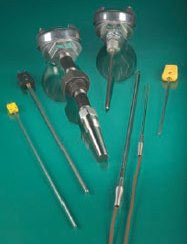A K-type thermocouple is a dependable and compact temperature-sensing solution for many industrial environments, including food service, hospitals, and laboratories. Its integrated composition of Chromel and Alumel wires makes it long-lasting, reliable in extreme conditions, and highly accurate (+/- 2.2 degrees Celsius). K-type thermocouples can accurately read temperatures between -270 to 1,260 degrees Celsius.
| Thermocouple Type | Temperature Range: Fahrenheit | Temperature Range: Celsius | Accuracy | Special |
| K | -454°F – 2,300°F | -270°C – 1260°C | +/- .75% +/- 2.2C | 0.4% +/- 1.1C |
Common Applications
Chemical and petroleum industries prefer K-type thermocouples for their wide temperature range and affordability.
K Type Thermocouple Composition
The K type thermocouple probe is made of chromel and alumel. Alumel is a composite of silicon, manganese, aluminum and nickel, while chromel is composed of chrome and nickel. While inexpensive, a K type will still cost you more than a J type; however, the K type makes up for it by being able to read a wider temperature range than the J type thermocouple. Hi-Watt, Inc. carries a wide variety of thermocouple types as well as thermocouple wire, contact us for details.
K types are also more resistant to corrosion than the iron-containing J types. While thermocouples made of noble materials, such as the S, R or B types, do not experience aging of the emf characteristic as the K type does, the K type is touted as being the most stable among other thermocouples made of inexpensive materials.
While a B type thermocouple can withstand incredibly high temperatures, you must be willing to pay the price of the platinum if you choose to use one.
Keeping these features in mind, the question that arises is which sheathing composition, also known as a junction, is most optimal for the K type thermocouple.
Advantages to an Exposed Thermocouple

If you are not working with any corrosive materials, you might find a benefit in using a bare wire junction. This simply means inserting the connected end into the process you need to read the temperature of, without any sheathing.
The primary advantage to this layout is that you will get the fastest response to changes in temperatures. However, it is often advised not to use this method as it is more likely for the wires to degrade through corrosion.
Sheathed Thermocouple Junctions
When you choose a sheathed junction, you have a decision to make as to whether to go grounded or ungrounded. An ungrounded thermocouple keeps the wires welded together while covering them with a sheath. There may be an added layer of insulation between the sheath and the wires to protect from electrical interference.
The feature that makes this junction ungrounded is that the wires never actually come into contact with the sheath. This layout may serve you better if you are concerned about electrical interference, but do not need fast response times.
On the other hand, a grounded junction acts for many users as a middle ground between an exposed and ungrounded layout. With this design, the wires and sheath are all welded together. The problem that some people run into with this layout is that it is susceptible to electrical interference. However, in certain environments, a faster response time is necessary, and that is made possible due to the ease of heat transfer from the sheath to the wires.
If you need a faster response time but are concerned about corrosion, a grounded thermocouple may be better suited for your situation.
Hi-Watt Customizes K-Type Thermocouples
K-type thermocouples can be cost-effective temperature-sensing solutions for many industries. If you need help finding your solution, reach out to Hi-Watt. We offer a wide range of thermocouple solutions and can customize our products to meet your unique needs.
Complete our online form today to get help from one of our experts.
Speak with an expert
Over last 8 years we have addressed 95% of inside sales quoting requests within 3 hours.
